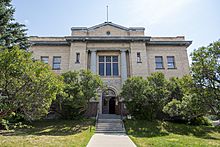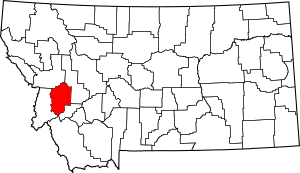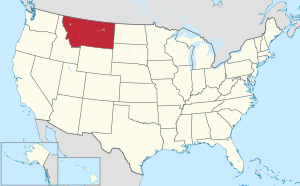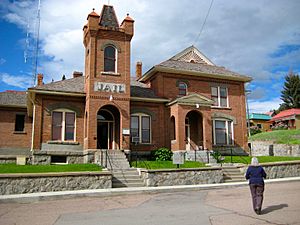Granite County, Montana facts for kids
Quick facts for kids
Granite County
|
|
|---|---|

Granite County Courthouse
|
|

Location within the U.S. state of Montana
|
|
 Montana's location within the U.S. |
|
| Country | |
| State | |
| Founded | March 2, 1893 |
| Seat | Philipsburg |
| Largest town | Philipsburg |
| Area | |
| • Total | 1,733 sq mi (4,490 km2) |
| • Land | 1,727 sq mi (4,470 km2) |
| • Water | 5.6 sq mi (15 km2) 0.3% |
| Population
(2020)
|
|
| • Total | 3,309 |
| • Estimate
(2022)
|
3,502 |
| • Density | 1.9094/sq mi (0.7372/km2) |
| Time zone | UTC−7 (Mountain) |
| • Summer (DST) | UTC−6 (MDT) |
| Congressional district | 1st |
|
|
Granite County is a county located in the state of Montana, United States. It's a place where people live and work. In 2020, about 3,309 people called Granite County home. The main town and county seat is Philipsburg.
Granite County was officially started in 1893. It got its name from a nearby mountain. This mountain was famous for the Granite Mountain silver mine.
Contents
Exploring Granite County's Geography
Granite County covers a large area in Montana. It has beautiful landscapes and important natural features.
What is the Size of Granite County?
According to the United States Census Bureau, Granite County is about 1,733 square miles big. Most of this area, about 1,727 square miles, is land. Only a small part, about 5.6 square miles, is water.
Major Roads and Routes in Granite County
Several important roads pass through Granite County. These roads help people travel and connect different communities.
 Interstate 90
Interstate 90 U.S. Highway 10 (This road used to be a major highway here)
U.S. Highway 10 (This road used to be a major highway here) U.S. Highway 12
U.S. Highway 12 Montana Highway 1
Montana Highway 1 Montana Highway 38
Montana Highway 38
Neighboring Counties of Granite County
Granite County shares its borders with several other counties in Montana.
- Missoula County to the north
- Powell County to the east
- Deer Lodge County to the south
- Ravalli County to the west
Protected Natural Areas in Granite County
Parts of two large national forests are found within Granite County. These forests help protect nature and offer places for outdoor activities.
- Deerlodge National Forest (a section of it)
- Lolo National Forest (a section of it)
Understanding Granite County's Population
The number of people living in Granite County has changed over the years. Here's a look at how the population has grown and shifted.
| Historical population | |||
|---|---|---|---|
| Census | Pop. | %± | |
| 1900 | 4,328 | — | |
| 1910 | 2,942 | −32.0% | |
| 1920 | 4,167 | 41.6% | |
| 1930 | 3,013 | −27.7% | |
| 1940 | 3,401 | 12.9% | |
| 1950 | 2,773 | −18.5% | |
| 1960 | 3,014 | 8.7% | |
| 1970 | 2,737 | −9.2% | |
| 1980 | 2,700 | −1.4% | |
| 1990 | 2,548 | −5.6% | |
| 2000 | 2,830 | 11.1% | |
| 2010 | 3,079 | 8.8% | |
| 2020 | 3,309 | 7.5% | |
| 2022 (est.) | 3,502 | 13.7% | |
| U.S. Decennial Census 1790–1960, 1900–1990, 1990–2000, 2010–2020 |
|||
Population in 2020
The 2020 census counted 3,309 people living in Granite County.
Population in 2010
In 2010, there were 3,079 people in the county. These people lived in 1,417 households. About 911 of these were families. The average number of people in a household was 2.14. The average age of people in the county was about 52.1 years old.
Most people in Granite County in 2010 were white (97.5%). A small number were American Indian (0.4%) or from other backgrounds. Many people had German, Irish, English, or Norwegian family roots.
Communities in Granite County
Granite County has several towns and smaller communities. Some are still active, while others are now "ghost towns."

Towns in Granite County
These are the main towns where people live and work.
- Drummond
- Philipsburg (This is the county seat, meaning it's the main town for county government)
Census-Designated Places
These are areas that are like small towns but are not officially incorporated as towns.
Unincorporated Communities
These are smaller settlements that don't have their own local government.
- Beartown
- New Chicago
- Quigley
- Princeton
- Sherryl
- Stone
Ghost Towns in Granite County
These are places where people once lived and worked, but are now mostly empty. They often have historical buildings left behind.
See also
 In Spanish: Condado de Granite para niños
In Spanish: Condado de Granite para niños

